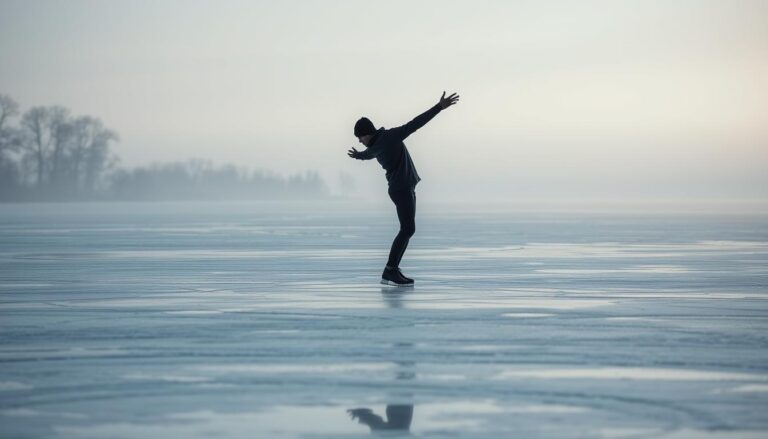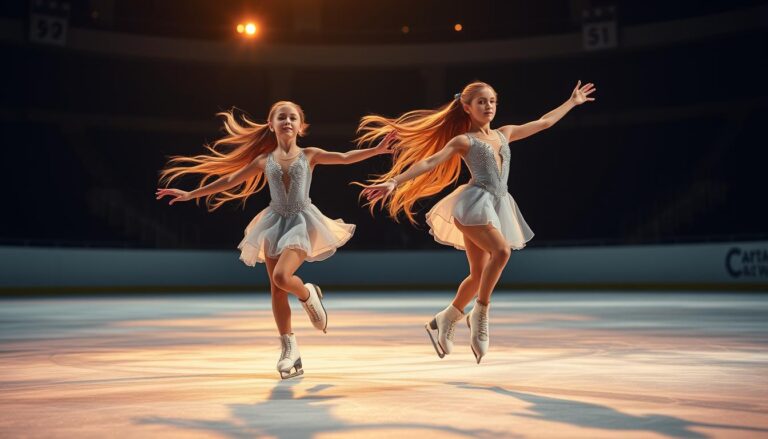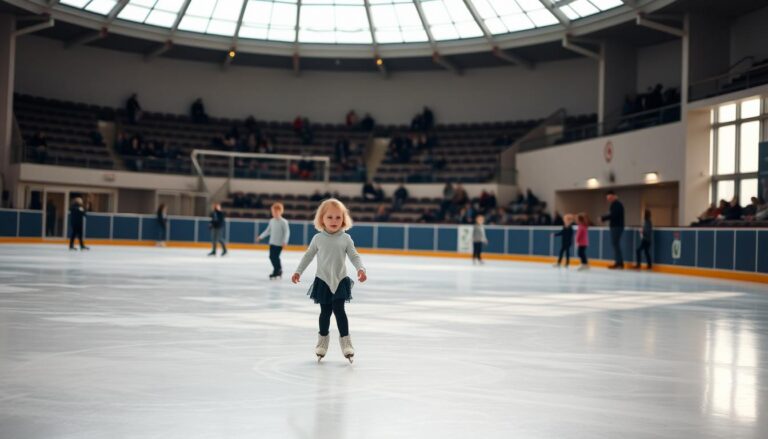Are Ice Skating Rinks Cold? What to Expect
Ice skating fans know the magic starts when they step into a cold arena. Yes, ice skating rinks are cold! They keep the ice at just the right temperature for skating. The ice is usually between 24 to 26 degrees Fahrenheit. This is cold enough to keep the ice solid but not too cold.
Knowing about ice rink temperatures is more than just about staying warm. It’s a science that affects your skating and the ice quality. Professional places use special technology to keep the ice perfect for skating.
Keeping ice rinks at the right temperature is a big job. It involves special cooling systems and constant checks. Even local rinks use advanced tech to make sure the ice is just right.
The cold helps the ice stay solid and keeps it from melting. It also makes the ice better for skating. Beginners and pros will see how the temperature affects their skating.
Professional skating places control their temperatures very carefully. They do this to help athletes perform better and keep everyone safe. Whether you’re learning new moves or just skating for fun, knowing about ice rink temperatures can make your experience better.
What you wear is important when it’s cold. Wear layers like thermal clothes, light jackets, and comfy pants. This helps you stay warm while you skate.
Getting ready for skating means embracing the cold. Every breath and every glide shows the amazing work that makes ice skating possible.
Understanding Ice Rink Temperature Basics
Ice skating arenas are carefully designed to control temperature. This is key to making the perfect skating surface. It’s a science that turns a simple floor into a smooth, gliding paradise.
The science behind ice formation is complex. Rink managers must balance many factors for the best skating conditions:
- Surface temperature is between 24-26°F
- Humidity levels need careful control
- Precise refrigeration systems manage heat transfer
The Physics of Ice Creation
Ice starts with a special concrete slab and cooling pipes. These pipes use a refrigerant solution to cool the surface. This keeps the ice frozen and consistent.
Temperature Precision in Skating
Professional ice rinks keep temperatures very steady. A small change can affect the ice’s quality. The goal is to make the ice hard enough for movement but soft to avoid brittleness.
Heat Transfer Dynamics
Heat transfer in ice rinks is about how energy moves. The refrigeration system removes heat from skaters, lighting, and air. This keeps the ice at its best.
- Skater body heat affects local ice temperature
- Lighting and crowd presence add thermal energy
- Special cooling systems fight these heat sources
Ice rink operators use these techniques to create magical places. Here, athletes and fun skaters enjoy perfect ice conditions.
Are Ice Skating Rinks Cold? The Simple Answer

Stepping into an ice skating rink, you feel the cold right away. Yes, ice skating rinks are cold. But they’re not as freezing as you might think. They keep the temperature between 45°F and 55°F, making it ideal for skating.
The science behind keeping ice rinks cool is interesting. They need to balance keeping the ice solid and keeping skaters comfortable. If it’s too warm, the ice gets soft. If it’s too cold, skaters might find it hard to move.
- Ice surface temperature: Around 24°F to 26°F
- Air temperature: 45°F to 55°F
- Rinkside areas: Slightly warmer than ice level
Both pros and hobbyists love these controlled temperatures. The cold actually helps skaters perform better. Colder ice means better glide and smoother movement.
The feeling of cold can change based on where you are in the rink. Those on the ice feel different temperatures than those watching from the stands. Special cooling systems keep the temperature steady everywhere.
Indoor vs Outdoor Ice Rink Temperature Differences
Skating fans face unique temperature challenges at indoor and outdoor rinks. The indoor and outdoor settings offer different skating experiences.
Ice skating happens in two worlds: indoor and outdoor. Each has its own temperature quirks that affect your skating.
Climate Control in Indoor Facilities
Indoor rinks keep the temperature just right for skating. They stay between 24-26°F, thanks to advanced cooling systems.
- Precise temperature monitoring
- Humidity control mechanisms
- Uniform ice surface maintenance
Weather Impact on Outdoor Rinks
Outdoor rinks are ruled by nature. The chill factor changes with the weather. Skaters must adjust to:
- Sunlight exposure
- Wind chill effects
- Ambient temperature variations
Seasonal Temperature Variations
Winter is the best time for outdoor skating. Indoor rinks stay the same all year. They offer a steady place for skaters to practice.
| Rink Type | Temperature Range | Consistency |
|---|---|---|
| Indoor Rinks | 24-26°F | High |
| Outdoor Rinks | 20-32°F | Low |
Whether you’re a pro or just for fun, knowing about these temperatures helps. It helps you pick the best place to skate.
How Ice Rinks Maintain Their Coldness
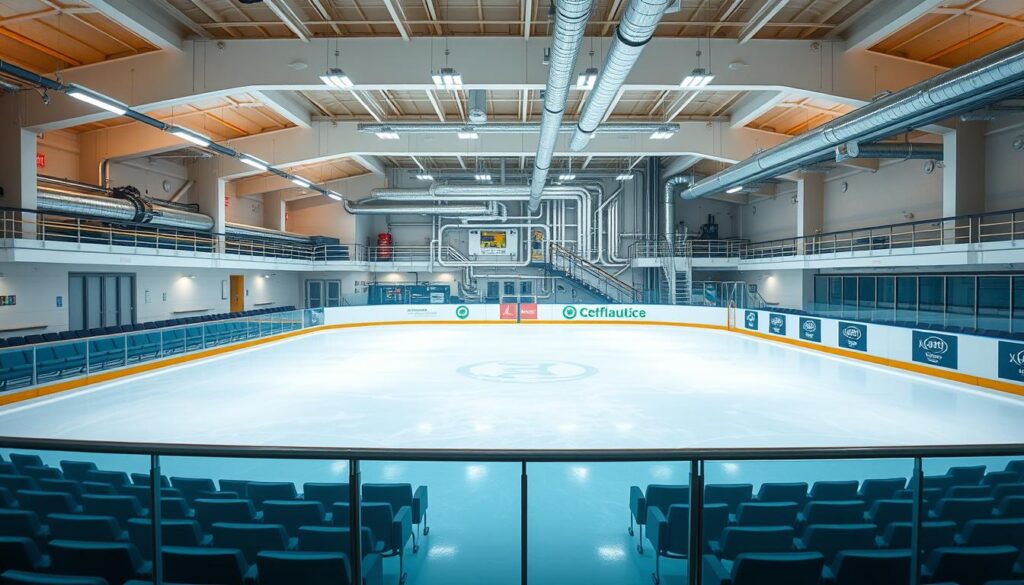
Keeping ice rinks cold is more than just turning down the heat. It’s a complex science. Professional ice skating facilities use advanced cooling systems to create the perfect skating surface.
The core of managing ice rink temperatures is a network of refrigeration technology. Underneath the ice, a system of pipes circulates coolants. These coolants remove heat, keeping the ice surface cold.
- Specialized refrigeration systems maintain temperatures between 16-24°F
- Constant monitoring of surface and ambient temperatures
- Advanced sensors track humidity and heat transfer
Modern rinks use the latest techniques to manage temperature. Thermal insulation is key in stopping heat from getting in. Thick concrete slabs with cooling pipes in them help keep the ice right.
Rink managers have to balance many things for the best skating:
- Controlling ambient air temperature
- Managing humidity levels
- Accounting for body heat from skaters
- Preventing external temperature fluctuations
New cooling technologies let some places reuse heat from cooling. This makes skating more energy-efficient and cheaper to run. It shows how keeping ice rinks cold is both a technical and environmental challenge.
The Perfect Temperature for Ice Skating Performance
Ice skating surface temperatures are key to a great skating experience. Each skating type needs a certain temperature for the best performance and safety.
Getting the temperature just right is essential for skating. The ice must be kept at the perfect level for all skating styles and skill levels.
Professional Hockey Standards
Hockey players need specific ice temperatures for the best game. Hockey rinks usually keep the ice at 16-24°F (-9 to -4°C). This helps with:
- Optimal puck control
- Reduced ice friction
- Maximum player performance
Figure Skating Requirements
Figure skaters need different ice conditions than hockey players. Precision is key in figure skating, which needs a firmer ice. The best temperature for figure skating is 24-28°F (-4 to -2°C).
Recreational Skating Conditions
Recreational skating rinks aim for a balance. They usually keep the ice at 22-26°F (-5 to -3°C). This makes it comfortable for skaters of all levels.
Knowing about ice skating surface temperatures helps skaters get ready for different rinks. Whether you’re a pro or just skating for fun, understanding these details can make your experience better.
What to Wear When Ice Skating
When you step into an ice skating arena, choosing the right clothes is key. Ice skating rinks are cold, so you need to dress right to stay warm and skate well. The right outfit can make your skating fun, not freezing.
Layering is the trick to staying warm in ice skating rinks. Skaters, pro or amateur, know that the right clothes keep you cozy without getting in the way.
- Base Layer: Wear moisture-wicking thermal underwear
- Mid Layer: Add a light fleece or performance jacket
- Outer Layer: Choose a windproof shell if needed
Choose clothes that keep you warm but let you move freely. Synthetic fabrics are great for this. They help keep your body heat in while you skate.
| Clothing Item | Recommended Material | Purpose |
|---|---|---|
| Pants/Leggings | Stretchy Synthetic Blend | Flexibility and Warmth |
| Top | Thermal Compression Shirt | Temperature Regulation |
| Socks | Wool/Synthetic Blend | Moisture Control |
Ice skating rinks are very cold, with temperatures between 45-55°F. So, wear the right clothes. And don’t forget to change into something warm after skating.
- Wear fitted gloves to protect hands
- Consider a lightweight beanie or ear warmers
- Pack dry clothes for after skating
Dress smartly to enjoy ice skating more. You’ll skate with confidence and stay warm.
Temperature Zones Within an Ice Rink
Ice skating facilities have interesting temperature changes. The coldness level at ice rinks is unique, changing from floor to ceiling. Skaters and spectators find different thermal zones, affecting comfort and fun.
The temperature at ice skating facilities isn’t the same everywhere. Skaters on the ice face a different cold environment than those watching from the stands. Here are the main temperature zones you’ll find:
Rink Surface Thermal Dynamics
At ice level, temperatures are between 20-24°F (-6 to -4°C). This cold ensures the ice is perfect for skating. Skaters’ movement adds heat, creating a special microclimate above the ice.
- Rink Surface Zone: The coldest area, keeping the ice just right
- Mid-Rink Air Zone: A bit warmer but crisp
- Spectator Area: Much warmer and more comfy
Vertical Temperature Variations
Temperature changes a lot with height. Skaters near the ice feel the most cold. Spectators higher up are much warmer.
| Height Level | Temperature Range | Comfort Level |
|---|---|---|
| Ice Surface | 20-24°F | Cold |
| 1-3 Feet Above Ice | 28-32°F | Chilly |
| Spectator Stands | 55-65°F | Comfortable |
Pro tip: Wear layers and pick your seat carefully. The closer to the ice, the colder you’ll feel.
Health and Safety Considerations in Cold Rinks
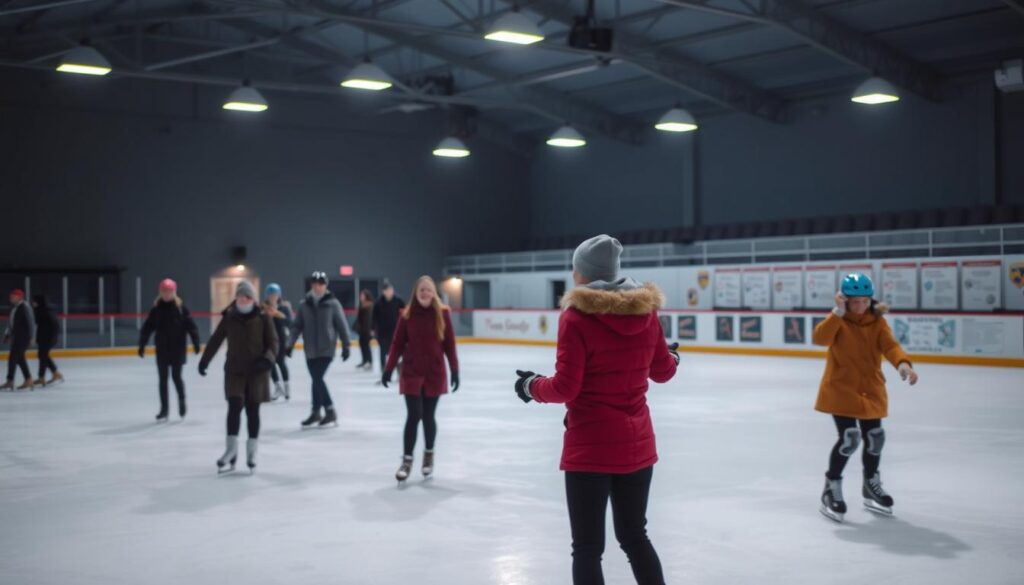
Ice skating rinks are very cold places that need careful planning for safety and comfort. The cold temperatures can be a challenge for everyone, no matter their skating skill.
It’s important to know the health risks in cold places. Cold can affect your body in ways you might not expect. So, getting ready is key.
- Protect yourself from muscle strains by warming up well before skating
- Wear the right layers that keep you flexible and warm
- Drink water, even when it’s cold
- Look out for signs of hypothermia or cold discomfort
People with health issues like asthma or Raynaud’s need to be extra careful. Talking to a doctor before going into cold activities is a good idea.
What you wear is very important in cold rinks. Think about wearing:
- Thermal base layers
- Moisture-wicking mid-layers
- Windproof outer layers
- Thick, warm socks
- Gloves or mittens
Knowing how your body reacts to cold can make skating safer and more fun. By being proactive, you can turn cold rinks into a great experience.
Energy Efficiency in Modern Ice Rinks
Ice skating facilities have changed a lot. They now use new tech to keep ice cold. This mix of science and green tech is amazing.
Today’s ice rinks are leading in energy saving. They use the latest tech to cut down on harm to the planet. And they keep the ice perfect for skating.
Advanced Cooling Systems Technology
New cooling tech has changed how rinks keep the ice right. These systems now have:
- Smart refrigeration controls
- Precision temperature monitoring sensors
- Energy-recovery heat exchange mechanisms
Environmental Impact Factors
Green ice rink design aims to cut down on carbon. It does this with smart strategies:
| Technology | Energy Savings | Environmental Benefit |
|---|---|---|
| CO2 Refrigeration Systems | 25-40% reduction | Lower greenhouse gas emissions |
| LED Lighting | Up to 75% electricity reduction | Decreased energy consumption |
| Thermal Insulation Upgrades | 20-30% cooling efficiency | Reduced energy waste |
Skating fans can enjoy their sport more. Modern facilities are getting greener and tech-savvy.
Common Misconceptions About Ice Rink Temperatures

Many people think ice skating rinks are always freezing. But, the truth is, rinks control their temperature to ensure the best skating experience. Knowing this can help you get ready for your next skate.
It’s common to believe rinks are always very cold. But, they’re actually kept at specific temperatures for skating. These temperatures might surprise you.
- Myth: Colder temperatures always mean better ice
- Reality: Precise temperature management is key to ice quality
- Ideal ice rink temperatures range between 24-28°F
Some think you need to wear lots of heavy clothes at ice rinks. But, indoor rinks are different. You need to dress smartly for the right temperature.
| Misconception | Actual Facts |
|---|---|
| All rinks are equally cold | Temperature varies by facility and skating purpose |
| Rinks are unbearably freezing | Carefully regulated for comfortable skating experience |
| Ice is always the same consistency | Temperature impacts ice texture and performance |
Learning about ice rink temperatures makes you a better skater. The science behind perfect ice is complex. It needs precise engineering.
- Professional hockey rinks have different temperature needs than figure skating venues
- Spectator areas are typically warmer than skating surfaces
- Humidity and crowd size impact overall rink temperature
Next time you go to an ice rink, you’ll know more about the temperature. You’ll understand the world of ice rink temperatures better.
Impact of Crowd Size on Rink Temperature
Skaters often notice changes in indoor ice rink conditions when crowds fill the arena. The ice skating arena climate can change a lot with the number of people. This creates a unique thermal environment that challenges rink managers.
Body heat is a big factor in changing indoor ice rink conditions. Each person adds about 100 watts of thermal energy. This can warm the air and ice surface around them. During peak hours, this effect gets even stronger.
- Small crowds (0-50 people): Minimal temperature impact
- Medium crowds (50-100 people): Noticeable warming effect
- Large crowds (100+ people): Substantial temperature shift
Professional rink operators use advanced cooling systems to fight the heat from crowds. Sophisticated refrigeration technology helps keep the ice quality consistent. It adjusts cooling based on real-time thermal readings.
Skaters looking for the best ice conditions might want to skate early or during less busy times. These times usually have better ice skating arena climate. The ice is smoother and the temperatures are more consistent.
Knowing about these temperature changes can help you pick the best skating times. It also shows the complex thermal management behind every ice rink experience.
Seasonal Maintenance and Temperature Adjustments
Ice skating facilities face unique challenges all year. Keeping the ice cold needs smart strategies that change with the seasons. Rink managers must always check and tweak the ice temperature for the best skating.
Skating fans might not know the hard work to keep ice perfect all year. Managing temperature is a key skill for rink operators.
Summer Operations: Cooling Challenges
In summer, keeping ice cold is a complex task. Rinks use advanced cooling systems to fight off heat:
- Powerful refrigeration units work hard
- Special insulation keeps temperatures steady
- Humidity control systems keep ice quality high
Winter Modifications: Precision Temperature Control
Winter has its own temperature needs. The ice skating facility temperature must be just right for perfect skating.
- Less need for cooling in winter
- More precise temperature adjustments
- Better ice surface prep techniques
Professional rinks use advanced systems to monitor and adjust temperatures. The aim is always a consistent, high-quality skating experience, no matter the weather.
Skaters enjoy perfect ice surfaces all year thanks to these efforts. The science behind ice maintenance shows the amazing skill needed for perfect skating environments.
How Weather Affects Indoor Rink Temperatures
Many think indoor ice rinks stay the same all the time. But, the weather outside really matters. Top ice skating places use special systems to keep the ice perfect.
Weather affects indoor ice skating in big ways. Here’s how:
- Humidity levels affect the ice’s quality
- Barometric pressure changes how cooling systems work
- Changes in outdoor temperature make keeping the ice cool harder
- Wind direction can make the building’s insulation better or worse
Today’s rinks use the latest tech to fight weather problems. Climate control engineers tweak the cooling systems to keep the ice just right. This way, skating is always great, no matter the season.
| Weather Factor | Impact on Indoor Rink | Mitigation Strategy |
|---|---|---|
| High Humidity | Reduces Ice Hardness | Dehumidification Systems |
| Extreme Cold | Increases Cooling Efficiency | Adjusted Refrigeration Cycles |
| Atmospheric Pressure | Alters Ice Crystal Formation | Precision Temperature Control |
Skaters can count on top rinks to keep the ice perfect. They work hard to make sure skating is always great, no matter the weather outside.
Conclusion
Exploring ice rink temperatures opens a world of precision and science. Yes, ice skating rinks are cold. But they’re more than just chilly places. Modern rinks are carefully set up to balance temperature, performance, and comfort.
Ice rink temperatures are key for a great skating experience. Whether it’s a pro hockey arena or a local rink, the right temperature is essential. The cooling systems and climate control make sure the ice is always perfect for skating.
When you skate, remember the science behind keeping the ice cold. The cool air you feel comes from advanced technology and a deep understanding of science. So, next time you skate, think about the amazing engineering that keeps the ice smooth and cool.
Learning about ice rink temperatures can make your skating better. Whether you’re interested in the science or just want to enjoy skating, knowing about temperatures makes it more special. So, get your skates ready, enjoy the cool, and let the magic of the ice take you on an adventure.

